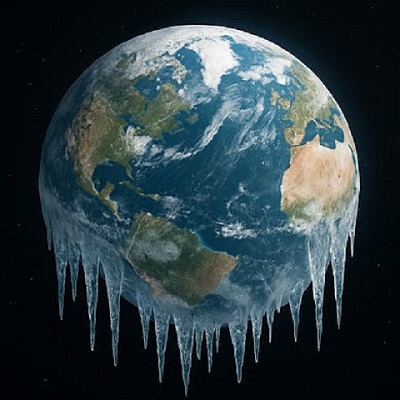International
Ice Surprises – Arctic and Antarctic Ice Sheets Are Stabilizing and Growing

 The Honest Broker
The Honest Broker  Roger Pielke Jr.
Roger Pielke Jr.
New climate research in science and policy context
Earlier this week the New York Post asked me to help its readers make sense of some surprising new research on ice dynamics at both poles. The new research appears in a new peer-reviewed paper and a preprint that was just posted.
At the South Pole, Wang et al. 2025 find a record accumulation of ice on the Antarctic ice sheet over the period 2021 to 2023, following a steady decrease from 2002 to 2021. The data comes from NASA’s GRACE series of satellites, which have the ability to precisely measure ice mass.
The figure below shows that the recent accumulation is small in the context of the multi-decadal decline, but is still characterized by the paper’s authors as a “significant reversal.” The paper makes no predictions of whether or how long the accumulation might continue.
At the other end of the planet, at the North Pole, a new preprint by England et al. identifies a “surprising, but not unexpected multi-decadal pause in Arctic sea ice loss.”¹ Their data can be seen below.
 |
From the caption to the figure: “(a,b )Observed sea ice area [106 km2] 1979-2024, (c,d) 20 year-trends of September sea ice area [106 km2/decade] with varying end year from 1998 to 2024, in which the red shaded envelope shows the bounds inside which a linear trend is not statistically significant according to a t-test at 95% confidence.” Source: England et al.
Disucssing these new papers and their significance, my op-ed for the NY Post starts as follows:
When it comes to climate change, to invoke one of Al Gore’s favorite sayings, the biggest challenge is not what we don’t know, but what we know for sure but just isn’t so.
Two new studies show that the Earth’s climate is far more complex than often acknowledged, reminding us of the importance of pragmatic energy and climate policies.
One of them, led by researchers at China’s Tongji University, finds that after years of ice sheet decline, Antarctica has seen a “surprising shift”: a record-breaking accumulation of ice.
The paper takes advantage of very precise measurements of Antarctic ice mass from a series of NASA satellites called GRACE (Gravity Recovery and Climate Experiment).
Since the first GRACE satellite was launched in 2002, Antarctica has seen a steady decline in the total mass of its glaciers. Yet the new study found the decline reversed from 2021 to 2023.
Melting Antarctic ice contributes to global sea-level rise, so a reversal of melting will slow that down. Understanding the dynamics of ice mass on Antarctica is thus essential.
The recent Antarctica shift makes only a small dent in the overall ice loss from 2022, but comes as a surprise nonetheless.
A second new paper, a preprint now going through peer review, finds a similar change at the opposite end of the planet.
Antarctic ice has made a turnaround, scientists say, with an increase in ice mass after years of depletion.
Antarctic ice has made a surprising rebound in mass, scientists say
“The loss of Arctic sea ice cover has undergone a pronounced slowdown over the past two decades, across all months of the year,” the paper’s US and UK authors write.
They suggest that the “pause” in Arctic sea ice decline could persist for several more decades.
Together, the two studies remind us that the global climate system remains unpredictable, defying simplistic expectations that change moves only in one direction.
In 2009, then-Sen. John Kerry warned that the Arctic Ocean would be ice-free by 2013: “Scientists tell us we have a 10-year window — if even that — before catastrophic climate change becomes inevitable and irreversible,” he said.
Today, six years after that 10-year window closed, catastrophic climate change has not occurred, even as the planet has indeed continued to warm due primarily to the combustion of fossil fuels.
Partisans in the climate debate should learn from Kerry’s crying wolf.
On one side, catastrophizing climate change based on the most extreme claims leads to skepticism when the promised apocalypse fails to occur on schedule.
On the other side, studies like the two surprising polar-ice papers reveal climate complexities, but don’t prove climate change isn’t real and serious. . .
This last point is important — climate research is not a scoreboard in a Manichean debate, but instead offers certainties, uncertainties, and even areas of total ignorance that establish a nuanced context for developing robust mitigation and adaptation policies.
The rest of my piece discusses this context. Please head over to the NY Post to read the whole thing and then come back to THB and tell me what you think.
One bit of my original draft was cut for space reasons. Here is that part:
Core understandings of climate science have remained remarkably constant over many decades – Humans affect the climate system in many ways, including greenhouse gas emissions, but also through land management, air pollution, and vegetation dynamics. At a planetary scale the net effect of these changes – driven by carbon dioxide emissions from the burning of coal, natural gas, and oil – is a warming of the planetary system. Anticipating regional and local consequences is far more challenging.
Irreducible uncertainties mean that climate variability and change are about risk management. As the late climate scientist Steve Schneider lamented in 2002, “I readily confess a lingering frustration: uncertainties so infuse the issue of climate change that it is still impossible to rule out either mild or catastrophic outcomes, let alone provide confident probabilities for all the claims and counterclaims made about environmental problems.”
Risk management means that as we balance competing objectives in energy policy we should look for opportunities to reduce costs, increase access, ensure security and reduce the human influences on the environment.
The published version ends with may call for policy makers to keep their eyes on the ball:
The surprises revealed by the two new papers about polar ice also remind us that we need to be prepared for unexpected behavior of the climate system, regardless of the underlying causes of change.
History tells us that climate can shift abruptly, with profound consequences for society.
For instance, the 1870s saw a wide range of climate extremes across the planet, by some estimates contributing to the deaths of 4% of global population.
More recently, the climate extremes of the 1970s led to many new US government programs focused on monitoring and researching climate, such as the National Oceanic and Atmospheric Administration.
Such efforts are crucially important because we can’t always anticipate the results of research. If we could, we wouldn’t need data and science.
Perhaps the most important lesson to take from the new polar-ice findings is that ongoing efforts in Washington, DC to gut climate data and research are deeply misguided.
The global climate system has more surprises in store for us — and we ignore them at our peril.
Read the whole thing here.
Next week here at THB and elsewhere, I’ll have much more on NOAA and current efforts to gut climate data and research.
Before letting you go today — last week I sat down with John Hook from Fox 10 in Phoenix and engaged in a deep discission of climate science and energy policy. You can see the full interview below. Thanks to John for the opportunity and the informed questions — I enjoyed the interview and the chance to explore nuances of climate and energy.
If you value the efforts here at The Honest Broker to contextualize science in policy and politics,
please consider subscribing, sharing, and supporting.
THB exists because of your support.
International
Australian PM booed at Bondi vigil as crowd screams “shame!”

Australian Prime Minister Anthony Albanese faced a wave of public anger Sunday when he appeared at a memorial vigil at Bondi Beach honoring the victims of last week’s brutal terrorist attack on a Hanukkah celebration. The Labor leader was met with loud boos, cries of “shame,” and jeers of “you are not welcome” from furious attendees who blame his government for failing to confront a rise in antisemitism.
Albanese, accompanied by his wife and security detail, appeared visibly rattled as shouts of “blood on your hands” rang out while he walked through the crowd. The hostility didn’t let up during the vigil itself—when the prime minister’s name was mentioned by a speaker, fresh boos erupted.
“Shame on You”
“You are NOT welcome”
Bondi, Australia – Australian Prime Minister @AlboMP heckled by mourners of Bondi Chanukah Massacre@theage @theheraldsun @australian @abcnews @SBSNews @cnnbrk @Jerusalem_Post @nytimes @BBCBreaking @9NewsAUS @10NewsAU @7NewsMelbourne pic.twitter.com/C2xusWFDxQ
— Menachem Vorchheimer (@MenachemV) December 21, 2025
Critics are now intensifying their attacks on Albanese’s left-wing administration, accusing it of turning a blind eye to Jewish concerns in the wake of Hamas’ October 7 rampage in Israel. Among them is Israeli Prime Minister Benjamin Netanyahu, who last week publicly condemned Albanese in an interview with Sky News Australia, saying the terrorist violence in Bondi was “preventable” and that his government had ignored clear warnings about a brewing antisemitic threat.
Footage unearthed by Sky News has only added fuel to the fire. In the video, a younger Albanese is seen at a pro-Palestinian rally standing beside signs declaring “Stop the Israeli Slaughter: Free Palestine Now.” During that demonstration, the future prime minister took aim at Israel’s military, aligning himself with anti-Israel activists. Reports also resurfaced showing that Albanese traveled to meet with the late PLO leader Yasser Arafat in 1998—on a trip reportedly funded by the Palestinian Authority.
Despite the growing discontent, Jewish leaders urged the community not to lose hope. David Ossip, president of the New South Wales Jewish Board of Deputies, opened the Bondi vigil by acknowledging the deep pain felt across the country, calling last week’s massacre a turning point. “We have lost our innocence… our nation has been stained,” Ossip said. But he pointed to the message of Hanukkah as a source of strength: “A single act of courage, a single flame of hope, can give us direction and point the path forward.”
That message stood in stark contrast to the political reality facing Albanese, whose approval ratings have been shaken by his perceived indifference and growing ties to far-left factions that demonize Israel. The backlash now confronting him is not just about a vigil—it’s about years of silence, a pattern of political posturing, and a government many feel has abandoned the people it claims to represent.
Crime
The Uncomfortable Demographics of Islamist Bloodshed—and Why “Islamophobia” Deflection Increases the Threat


Addressing realities directly is the only path toward protecting communities, confronting extremism, and preventing further loss of life, Canadian national security expert argues.
After attacks by Islamic extremists, a familiar pattern follows. Debate erupts. Commentary and interviews flood the media. Op-eds, narratives, talking points, and competing interpretations proliferate in the immediate aftermath of bloodshed. The brief interval since the Bondi beach attack is no exception.
Many of these responses condemn the violence and call for solidarity between Muslims and non-Muslims, as well as for broader societal unity. Their core message is commendable, and I support it: extremist violence is horrific, societies must stand united, and communities most commonly targeted by Islamic extremists—Jews, Christians, non-Muslim minorities, and moderate Muslims—deserve to live in safety and be protected.
Yet many of these info-space engagements miss the mark or cater to a narrow audience of wonks. A recurring concern is that, at some point, many of these engagements suggest, infer, or outright insinuate that non-Muslims, or predominantly non-Muslim societies, are somehow expected or obligated to interpret these attacks through an Islamic or Muslim-impact lens. This framing is frequently reinforced by a familiar “not a true Muslim” narrative regarding the perpetrators, alongside warnings about the risks of Islamophobia.
These misaligned expectations collide with a number of uncomfortable but unavoidable truths. Extremist groups such as ISIS, Al-Qaeda, Hamas, Hezbollah, and decentralized attackers with no formal affiliations have repeatedly and explicitly justified their violence through interpretations of Islamic texts and Islamic history. While most Muslims reject these interpretations, it remains equally true that large, dynamic groups of Muslims worldwide do not—and that these groups are well prepared to, and regularly do, use violence to advance their version of Islam.
Islamic extremist movements do not, and did not, emerge in a vacuum. They draw from the broader Islamic context. This fact is observable, persistent, and cannot be wished or washed away, no matter how hard some may try or many may wish otherwise.
Given this reality, it follows that for most non-Muslims—many of whom do not have detailed knowledge of Islam, its internal theological debates, historical divisions, or political evolution—and for a considerable number of Muslims as well, Islamic extremist violence is perceived as connected to Islam as it manifests globally. This perception persists regardless of nuance, disclaimers, or internal distinctions within the faith and among its followers.
THE COST OF DENIAL AND DEFLECTION
Denying or deflecting from these observable connections prevents society from addressing the central issues following an Islamic extremist attack in a Western country: the fatalities and injuries, how the violence is perceived and experienced by surviving victims, how it is experienced and understood by the majority non-Muslim population, how it is interpreted by non-Muslim governments responsible for public safety, and how it is received by allied nations. Worse, refusing to confront these difficult truths—or branding legitimate concerns as Islamophobia—creates a vacuum, one readily filled by extremist voices and adversarial actors eager to poison and pollute the discussion.
Following such attacks, in addition to thinking first of the direct victims, I sympathize with my Muslim family, friends, colleagues, moderate Muslims worldwide, and Muslim victims of Islamic extremism, particularly given that anti-Muslim bigotry is a real problem they face. For Muslim victims of Islamic extremism, that bigotry constitutes a second blow they must endure. Personal sympathy, however, does not translate into an obligation to center Muslim communal concerns when they were not the targets of the attack. Nor does it impose a public obligation or override how societies can, do, or should process and respond to violence directed at them by Islamic extremists.
As it applies to the general public in Western nations, the principle is simple: there should be no expectation that non-Muslims consider Islam, inter-Islamic identity conflicts, internal theological disputes, or the broader impact on the global Muslim community, when responding to attacks carried out by Islamic extremists. That is, unless Muslims were the victims, in which case some consideration is appropriate.
Quite bluntly, non-Muslims are not required to do so and are entitled to reject and push back against any suggestion that they must or should. Pointedly, they are not Muslims, a fact far too many now seem to overlook.
The arguments presented here will be uncomfortable for many and will likely provoke polarizing discussion. Nonetheless, they articulate an important, human-centered position regarding how Islamic extremist attacks in Western nations are commonly interpreted and understood by non-Muslim majority populations.
Non-Muslims are free to give no consideration to Muslim interests at any time, particularly following an Islamic extremist attack against non-Muslims in a non-Muslim country. The sole exception is that governments retain an obligation to ensure the safety and protection of their Muslim citizens, who face real and heightened threats during these periods. This does not suggest that non-Muslims cannot consider Muslim community members; it simply affirms that they are under no obligation to do so.
The impulse for Muslims to distance moderate Muslims and Islam from extremist attacks—such as the targeting of Jews in Australia or foiled Christmas market plots in Poland and Germany—is understandable.
Muslims do so to protect their own interests, the interests of fellow Muslims, and the reputation of Islam itself. Yet this impulse frequently collapses into the “No True Scotsman” fallacy, pointing to peaceful Muslims as the baseline while asserting that the attackers were not “true Muslims.”
Such claims oversimplify the reality of Islam as it manifests globally and fail to address the legitimate political and social consequences that follow Islamic extremist attacks in predominantly non-Muslim Western societies. These deflections frequently produce unintended effects, such as strengthening anti-Muslim extremist sentiments and movements and undermining efforts to diminish them.
The central issue for public discourse after an Islamic extremist attack is not debating whether the perpetrators were “true” or “false” Muslims, nor assessing downstream impacts on Muslim communities—unless they were the targets.
It is a societal effort to understand why radical ideologies continue to emerge from varying—yet often overlapping—interpretations of Islam, how political struggles within the Muslim world contribute to these ideologies, and how non-Muslim-majority Western countries can realistically and effectively confront and mitigate threats related to Islamic extremism before the next attack occurs and more non-Muslim and Muslim lives are lost.
Addressing these realities directly is the only path toward protecting communities, confronting extremism, and preventing further loss of life.
Ian Bradbury, a global security specialist with over 25 years experience, transitioned from Defence and NatSec roles to found Terra Nova Strategic Management (2009) and 1NAEF (2014). A TEDx, UN, NATO, and Parliament speaker, he focuses on terrorism, hybrid warfare, conflict aid, stability operations, and geo-strategy.
The Bureau is a reader-supported publication.
To receive new posts and support my work, consider becoming a free or paid subscriber.
-

 Censorship Industrial Complex2 days ago
Censorship Industrial Complex2 days agoDeath by a thousand clicks – government censorship of Canada’s internet
-

 Daily Caller2 days ago
Daily Caller2 days agoChinese Billionaire Tried To Build US-Born Baby Empire As Overseas Elites Turn To American Surrogates
-

 Digital ID2 days ago
Digital ID2 days agoCanada releases new digital ID app for personal documents despite privacy concerns
-

 Community2 days ago
Community2 days agoCharitable giving on the decline in Canada
-

 Alberta17 hours ago
Alberta17 hours agoAlberta’s huge oil sands reserves dwarf U.S. shale
-

 Alberta2 days ago
Alberta2 days agoSchools should go back to basics to mitigate effects of AI
-

 Bruce Dowbiggin2 days ago
Bruce Dowbiggin2 days agoNFL Ice Bowls Turn Down The Thermostat on Climate Change Hysteria
-

 Energy13 hours ago
Energy13 hours agoCanada’s sudden rediscovery of energy ambition has been greeted with a familiar charge: hypocrisy






